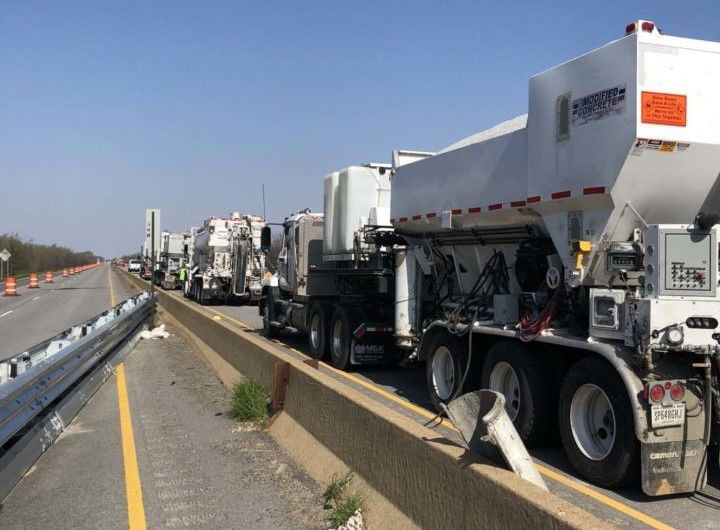Latex Modified Concrete - Importance of Flow Meters
Latex-modified concrete has been around since the 1960’s as a cost-effective way to repair bridge decks and roadways damaged by harsh climate changes (freeze, thaw, crack) and deicing salt that attacks the core steel structure and jeopardizes its integrity. Latex modified concrete has excellent bonding adhesion and durability, and higher tensile strength, compressive and flexural strengths all providing better freeze thaw performance and life cycle. A typical mixture of latex modified concrete consists of 24.5 gallons of latex per cubic yard of concrete.
The latex modified concrete mixture shall contain the minimum proportions of these materials:
- Cement – 658 pounds per cubic yard (94 Lbs per bag)
- Latex Emulsion Admixture – 24.5 gallons per cubic yard
- Fine Aggregate – 210 to 255 pounds (50% to 60% by total weight) per bag of cement
- Coarse Aggregate – 168 to 208 pounds per bag of cement
- Net Water – 154 pounds per cubic yard (18.5 gallons of water per cubic yard)
Properties of the latex modified concrete shall be as follows:
- Air Content – Zero to 7% maximum by volume of the plastic mix (Air entraining admixtures shall not be added). The use of the latex manufacturers’ recommended defoamer may be allowed as needed.
- Slump – 3 to 7 inches (measured 4 to 5 minutes after discharge from mobile mixer). During the waiting period the concrete shall not be disturbed. For VES, slump of 6 to 10 inches.
- Water-Cement Ratio – Maximum 0.40 (0.42 for VES), considering all non-solids as part of the mixing water and free water in aggregates as a part of total water cement ratio.
The concrete shall be volumetrically mixed at the bridge site by a self-contained, self-propelled, continuous type mobile mixer calibrated to accurately proportion the specified mix.
| Sufficient mixing capacity or number of mixers shall be provided to permit the intended pour to be placed without interruption. The mixer shall be capable of carrying enough quantity of unmixed ingredient to produce at least 6 cubic yards of LMC at the bridge site. The mixer should be equipped with a grounding strap. The concrete discharged from the mixer shall be uniform in composition and consistency. The mixer shall also measure and control the flow of ingredients being introduced into the mix and shall record these quantities on a visible recording meter equipped with a ticket printer. The flow of latex modifier shall be displayed by an approved flow meter. The latex system shall be equipped with a latex strainer to remove any solid particles during the operation of the mixer, and provide positive control of the latex emulsion into the mixing chamber. |  |
The mixer shall be capable of continuously circulating the latex emulsion. At any time, the engineer may request random one quart latex samples be taken for testing from tankers, or mobile mixers prior to placement on the deck. Coarse and fine aggregates shall be conditioned to avoid variations in the moisture content affecting the uniform consistency of the concrete. Aggregate bins shall be clean, with sand bin vibrators in good working order.
Water flow shall be readily adjustable to compensate for minor variations in aggregate moisture content and be displayed by an approved flow meter.
Over time the latex in the flow meters would solidify causing the flow meter to malfunction or not perform at all, down time to repair or replace damaged flow meter was costly. An important aspect of the mixing process is to ensure that the equipment is in excellent working condition and that the instruments used provide the right blend in the batch process.
With the mixer set at the required operating rpm, calibrate the accuracy of the water flow meter into a suitable container. The accuracy of the water flow meter shall be verified by setting the flow meter at 2 gallon per minute and discharging into a container during a one minute interval. Weighing the amount and dividing by 8.33 will determine the number of gallons. This procedure shall be repeated with the flow meter adjusted to 3 gallons per minute. A theoretical water setting on the flow meter can be determined by calculating total water required according to the mix design and then deducting for aggregate moisture and water in the latex emulsion.
The engineers at RCM Industries, Inc. developed an optional flush system to the standard flow meter enabling the operator to purge remaining latex in the piping system on site by simply closing ball valves upstream and downstream of the flow meter and flushing the system with water until clear. The flush system eliminated the need to repair or replace the flow meters reducing maintenance cost and down time.


